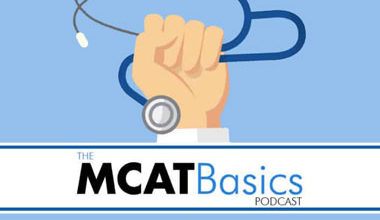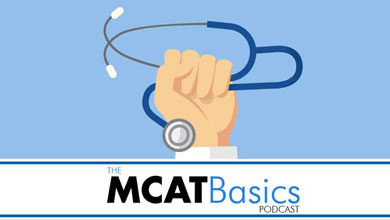Sam reviews aging concepts that show up on the MCAT. He covers aging at the cellular level, emphasizing the phenomena of telomere shortening and cell senescence. Then, he discusses aging in the brain and the Life Course Perspective, which are topics for the psychology/sociology section of the MCAT.
- [01:25] Aging at the Cellular Level
- [05:26] The Hayflick Limit
- [07:34] Telomere Shortening
- [09:53] Cell Senescence
- [11:09] Aging in the Brain
- [18:03] The Life Course Perspective
- [24:00] Social Significance of Aging
- [26:11] Demographic Structure of Society
Cellular Aging
The main signs of cellular aging are protein aggregation, telomere shortening, cell senescence, autophagy dysregulation, and mitochondrial dysfunction.
Protein aggregation occurs when disordered or misfolded proteins accumulate to form plaques. Plaques are insoluble protein clusters that can cause damage and lead to diseases like Alzheimer’s disease.
Telomere shortening is also a symptom of cellular aging. The ends of each chromosome contain telomeres, which are non-coding repeats (TTAGGG), that prevent the loss of genetic material during cell division. With each cell division, the telomeres become progressively shorter. This leads to a phenomenon known as cell senescence which occurs when cells no longer divide and remain frozen in the G1 phase of the cell cycle for the rest of their lifetime. So, telomere shortening and cell senescence are very linked.
As cells age, they become less effective at getting rid of or recycling dysfunctional proteins and organelles. This condition is called autophagy dysregulation. The lack of proper self-regulation can cause problems down the line.
Another malfunction that occurs as cells age is mitochondrial dysfunction. This can limit the production of ATP is which hinders cells from meeting their energy requirements.
The Hayflick Limit
It was initially believed that cells had the ability to continuously divide throughout life. However, Dr. Leonard Hayflick discovered that cells divide 50 to 70 times before they stop doing so. This limited capacity of cell replication is called the Hayflick limit.
Telomere Shortening and Cell Senescence
A somatic cell undergoes mitosis each time it divides. DNA is replicated and the cell splits into two. During this process, a small portion of genetic material at the chromosomes’ tips are lost in the lagging strand.
Fortunately, telomeres are non-coding pieces of DNA at the ends of chromosomes that prevent the loss of important genes. Telomeres are made up TTAGGG repeats. During cell replication, the telomeres get progressively shorter. If they are reduced below a critical level, cell division will cease. This state is called cell senescence. Senescent cells can no longer divide because the telomeres are too short and cell division would lead to loss of genetic material that encodes for important proteins. The cells are arrested in the G1 phase of the cell cycle. Although senescent cells are much, much less responsive to external stimuli, they remain metabolically active. Now, telomeres don’t just shorten. They can be rebuilt by an enzyme called telomerase. Telomerase contains an RNA primer that binds to and extends telomeres’ length – increasing the number of TTAGGG repeats that a particular telomere has.
Aging in the Brain
After the age of 40, brain size decreases by 5% per decade. The brain vasculature changes as well. There is less blood flow to the brain. Hormones and neurotransmitters in the brain fluctuate as we age. For the MCAT, it’s important to identify which cerebral processes remain stable, which ones improve, and which ones worsen over time.
Aging Worsens these Cognitive Functions:
- Episodic memory – refers to long-term memories of specific events and experiences.
- Recall – the ability to retrieve information from the brain. It is linked to episodic memory.
- Processing speed – the rate at which new information is understood.
- Divided attention – the ability to multitask. It can also refer to the skill of shifting focus between different stimuli.
Aging Improves these Cognitive Functions:
- Crystallized intelligence – one’s accumulated knowledge throughout life. As people age, they continue to learn and grow.
- Semantic memory – the ability to recall concepts and general facts. The information is not related to specific experiences.
- Emotional intelligence – the ability to understand social situations. This includes perception and regulation of your emotions and those of others.
Stable Cognitive Functions Throughout Life:
- Procedural memory – an implicit type of memory is involved in performing specific tasks like driving a car, playing an instrument, or tying shoelaces.
- Recognition – the ability to identify a stimulus that has been previously encountered. We are able to recognize places, faces, and objects that we’ve already seen.
The Life Course Perspective
To put it simply, the Life Course Theory is a sociological framework that considers an individual’s whole life experience to understand his or her physical, mental, and social health. The framework recognizes the importance of life stages and events in determining a person’s life trajectory. Take the Great Depression as an example. People who have lived through this historic event have been impacted in a meaningful way decades after it transpired.
Demographic Structure of Society
The demographic structure of society can be visually represented by a population pyramid plot. On the x-axis, you’ll find the age group and on the y-axis, you’ll find the relative population size. Younger populations will tend to have a pyramid shape. On the other hand, the plot of older societies resembles the shape of a house. It’s good to know how to read and interpret population pyramids for the MCAT. If you are unfamiliar, you read and see more here.
In the US, the current median age is 38 years old. Back in the 70’s, the median age was 28 years old. The number of people over the age of 65 have increased significantly over the years. The world has more aging societies than ever before because of higher life expectancy and lower birth rates. Older societies are at risk of putting more stress on their healthcare system.

